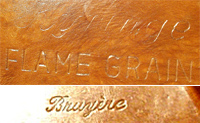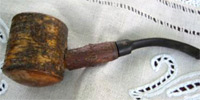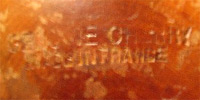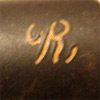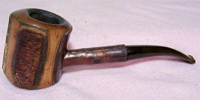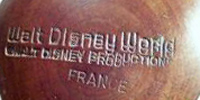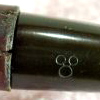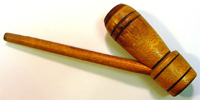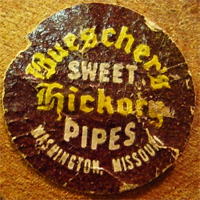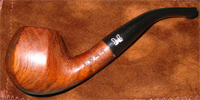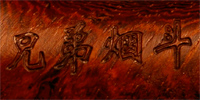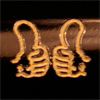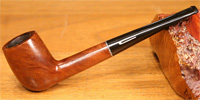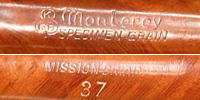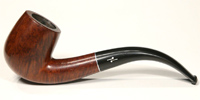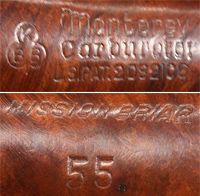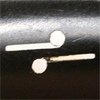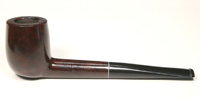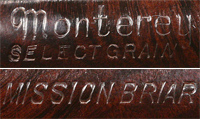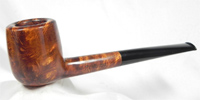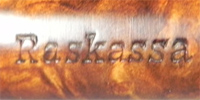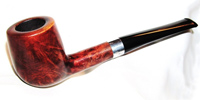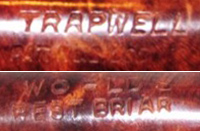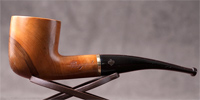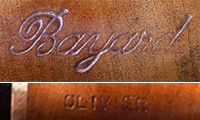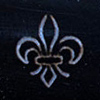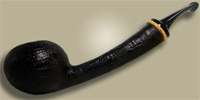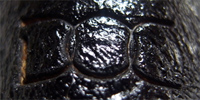- Beech -Fagus sylvatica-
- Cherry wood -Prunus avium-
- Hickory -Carya amara or cordiformis-
- Ji Chi Mu (Chicken Wing wood) -Ormosia-
- Manzanita -Arctostaphylos tomentosa-
- Mountain Laurel -Kalmia latifolia-
- Olive wood -Oleae Europae-
- Strawberry wood -Arbutus unedo-
- Unidentified wood
▲ (Left side)
Kyringe, Flame Grain
(Right side)
Bruyère
 Ropp
Ropp
Concorde 
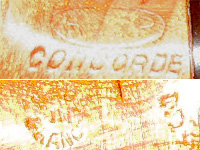
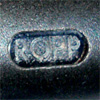
(Right side) Made in France (In circle), 3
Cherry wood pipe with bark.
Ropp stamped a cursive R on the stems of some of their export pipes.
▲ (Underside)
Buescher's (Arched)
Sweet Hickory Pipes
Washington Missouri
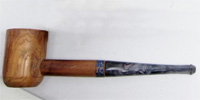
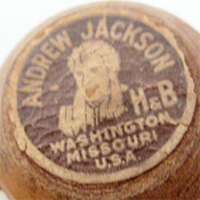

▲ (Underside)
Andrew Jackson (Arched)
H & B
Washington Missouri, U.S.A.
▲ (Left side)
兄弟烟斗 ( 兄弟 = Brothers 烟斗 = smoking pipe )
◊ (Right side)
0009/1000, Handmade in China
The tobacco shop is located in Yandaixiejie (Beijing) also called "Tobacco Pipe Lane".
Owner (2012): Mr Liu
The pipe is made out Chicken Wing wood (or Phoenix Tail wood). This name describes the tight and feather-like grain ressembling the iridescent quality on some chicken or pheasant's feathers (Chinese name: Ji chi mu 鸡翅木).
The wood is botanically classified in the Ormosia genus of which as many as twenty-six species may grow in China. Seven different species are reportedly utilized in arts and crafts (furniture).
Some Ormosia species are threatened by habitat destruction, while the Hainan Ormosia (O. howii) is probably extinct already.
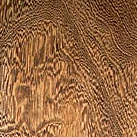
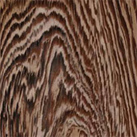
(Right side) Mission Briar, 37
▲ Faced with shortages of briar during World War II, Kaufman Brothers & Bondy used expedient sources and methods to maintain production. The most notable of these was the "Mission Briar" pipe made of Manzanita burl (Fam: Ericaceae) harvested in California. The Manzanita pipe production gradualy decreased from 1943 when Algerian briar shipments started again.
MONTEREY exists also as a full KB&B's sub-brand.
Other Manzanita pipes: Devonshire
▲ (Left side)
KBB (In clover), Monterey, Carburetor
US. PAT. 2082106
(Right side)
Mission Briar
55
▲ The 55 KB&B shape number seems to follow Kaywoodie's nomenclature (Bent Billiard). The Carburetor Pat. N° 2082106 is also the same as Kaywoodie's which produced Carburetor pipes from 1948 on. That could mean that the Manzanita (Mission Briar) pipes continued to be crafted long after WWII when Briar supply returned to normal for a long time.
This pipe also demonstrates the Manzanita grain has not always the monotony it is credited.
Monterey
(Left side) Monterey, Select Grain
(Right side) Mission Briar
According to Wilczak & Colwell (op. cit.) this brand would have been distributed by Otto Sevic (USA) 1930... (?).
Looking to the enlarged views the grain of the wood appears to correspond to Mountain Laurel.
▲ (Left side) Trapwell, Pat N° ....
(Right side) World's Best Briar
The brand was made by D & P Pipe Works, owned by D. P. Levitas and located in Sparta, Alleghany County, North Carolina close to the population of Mountain Laurel in the area. Later, this company changed its name to Sparta Pipe Works and still later to Sparta Industries.
Trapwell pipes marked with "World's best briar" are made of Mountain Laurel (Kalmia latifolia) a species from the Ericaceae family. The plant is toxic.
There were at least three pipe brands made from the Mountain Laurel: Trapwell, Breezewood and Custombilt.
Bayard
▲ (Underside)
DOC
Artisan: Roman Kovalev (born 1971) is a part time pipemaker spending 10 hours/day with his "hobby". the rest of his time he is a medical doctor (neurology) and that's why all his pipes are stamped DOC.
Markings: DOC, no gradings, no dating.
Other doctors carving pipes: Daniel Jud, Robert Kiess (Dr Bob)







 Meerschaum pipes
Meerschaum pipes Morta (Bog wood)
Morta (Bog wood) Miscellaneous
woods
Miscellaneous
woods



